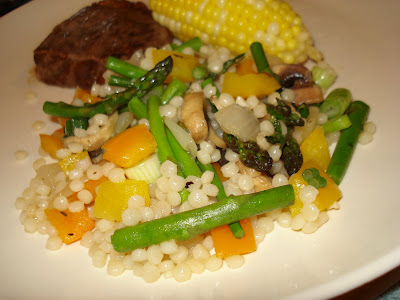Vegetable Couscous

1 c. Israeli couscous
1 c. Chicken stock, low sodium
1 c. Water
4 c. Vegetables, chopped
1 clove Garlic, chopped
1 tsp Basil, dried
2 tbsp Olive oil
Sesame oil
Salt & Pepper to taste

Rinse the couscous with water.
Bring the chicken stock and water to a boil in a sauce pan. Stir in the couscous. Reduce to low heat and simmer for about 10 min, covered.
When the couscous are soft, fluff with a fork. You may drain the excess liquid with a strainer.
Prepare approximately 4 cups of vegetables, chopped the way you like. I used mushrooms, asparagus, green onion, white onion and sweet peppers.
Heat the olive oil in a large frying pan. Add garlic and white onions and cook for about 1 minute until fragrant.
Stir in the basil and the rest of the vegetables (except for the green onion) and cook until they begin to soften. (Cooking time depends on whether you like your veggies soft or crunchy.)
If you are using green onion, add them to the rest of the vegetables and cook for a few more minutes.
Stir in the cooked couscous and season with salt and pepper. Drizzle a little bit of sesame oil before serving.
My comments:
I fell in love with Israeli couscous the first time I had it as a side dish at a fancy local restaurant. It was prepared with veal juice and oh boy, I'm drooling just thinking about it. I don't have any veal juice at home but I did have tons of vegetables that were going to go bad if I didn't do something about it. So I whipped up this simple vegetable couscous recipe and it was delicious, not to mention very healthy.
Israeli couscous actually tastes more like a pasta than the regular couscous. The package instruction said to "fluff" with a fork once the liquid is absorbed but it doesn't really "fluff". I found it helps to have a bit of oil (olive or sesame) to keep the couscous from sticking together too much. One important thing to remember when preparing couscous (regular or Israeli) is to use low sodium chicken stock. Once the stock is reduced and absorbed, the salt concentration increases and you end up with a very salty dish. So it is wise to start with a low sodium stock and add more salt as needed.

Comments